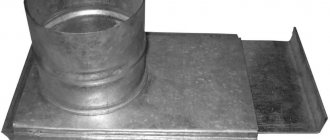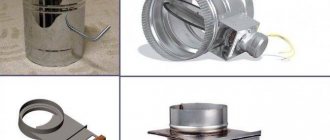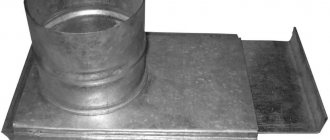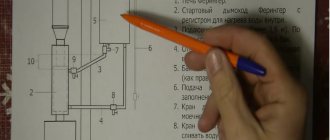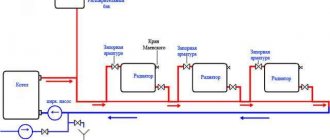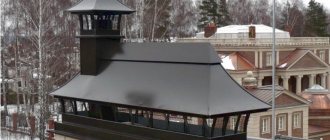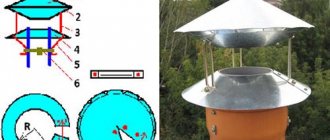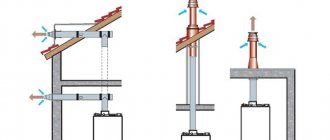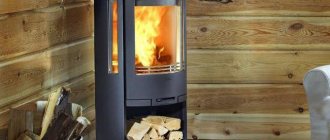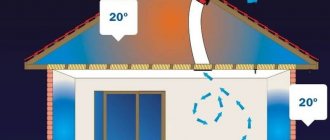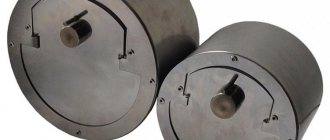- Cast iron
The functioning of stoves indoors or in a sauna directly depends on the installed chimney. From it, oxygen-saturated air is directed into the firebox, which is required to maintain stable combustion. The resulting smoke, soot and processed gases are removed from the room through a pipe. To regulate the combustion process and prevent heat loss, they resort to installing furnace rotary dampers for chimneys made of stainless steel and other materials.
What is it and what is it for?
Damper (from the German Schieber - damper) is a device for completely or partially blocking the movement of gases in the chimney. It has been used since the appearance of the first Russian stoves. Made from cast iron or steel. In modern engineering it has found application both in smoke exhaust structures and in ventilation systems.
Damper functions:
- Regulating draft and maintaining heat in the room.
The chimney is closed after use to prevent warm air from being drawn from the room into the chimney. Using a damper, you can reduce or increase the working cross-section of the chimney.
- Saving fuel consumption.
The valve can be used to regulate the intensity of oxygen flow to the flame, and accordingly increase or decrease the efficiency of the heater.
This statement is true only for furnaces and boilers without blowers and forced air supply devices.
Difference in models depending on material
Various materials can be used for the production of chimney valves: cast iron and steel. They have shown the most reliable performance characteristics, allowing them to be resistant to high temperatures.
Cast iron
Quite durable and long service life. Disadvantages:
- heavy weight, which increases the load on the structure;
- difficulties encountered during installation;
- in case of use in wet conditions - poor corrosion resistance.
Used in chimneys made of brick base.
Stainless steel
A device made from this material belongs to the universal category. Excellent for installation in stoves, fireplaces and chimneys made of brick (pre-lined with a stainless steel pipe) or metal.
Steel structures have a simpler appearance, but are not much inferior to cast iron in properties. Their significant advantage is their light weight, which reduces the load. In addition, they are mounted on all kinds of chimneys (rectangular and oval, heavy, made of brick, etc.). When choosing a damper for a furnace, you will need to take into account not only the operational properties, but also the overall interior of the room.
How the gate works
Structurally, the gate is a locking device with an adjustable valve. It is thanks to the displacement of the valve that the movement of gases in the chimney is regulated. Can be installed in chimneys of round, square and rectangular cross-section. It is a metal plate that moves inside the smoke channel in a certain way.
Gate valves can be of two types:
- Retractable. Moves in one plane back and forth.
- Rotary. Regulates air access by rotating around its axis.
In addition, valves can be manual or equipped with an electric drive. The cost of the latter is an order of magnitude higher and they are not used in chimneys.
Slider lever position
When the fireplace is operating, the damper is either half-open or open. The gate is completely covered (the closed position is the rotary valve plate across the channel) when trying to switch the fireplace to a slow combustion state (But fireboxes that have a gate are not always suitable for operating in this mode!). In some models of fireboxes, the damper is designed to fully open before opening the door (mechanical locking). And even in the “closed” position of the fireplace damper, there is a movement of flue gases and air through the channel (the system is determined by the standards, which is why manufacturers of fireplace inserts and chimneys initially make a loose damper).
Types and designs
The chimney damper is available in several versions.
Retractable
It is a round or rectangular frame with a plate. The plate extends and retracts, thereby adjusting the cross-section of the chimney.
This option is most often used with brick and ceramic channels. To ensure incomplete sealing and avoid carbon monoxide poisoning, a small hole is made in the plate. The main advantage of this option is ease of installation.
Rotary throttle
A rotary or throttle valve (also known as a hog valve) is a plate made of steel or cast iron that rotates around an axis. The axis is a metal rod welded inside the chimney. Used in steel chimneys.
It is less reliable - over time, the welding fastening of the plate and axle weakens. You should avoid installing a rotary damper in the bathhouse - even when closed, this type of damper partially allows steam to pass through.
In addition, gate valves differ in material (the most common are stainless steel and cast iron) and the method of adjustment.
Differences between retractable and rotary gates
The retractable damper allows you to adjust the working cross-section of the chimney, while the rotary damper only allows you to open or close the pipe. Of course, some tricks are possible - such as securing the hog in an intermediate position in different ways, but the factory equipment does not provide for this. In addition, the rotary gate complicates mechanical cleaning of the pipe.
The hog is often installed in metal chimneys, and the retractable one is installed in brick chimneys.
Home manufacturing technology
Qualified specialists always emphasize that even a novice craftsman can make a rotary and retractable gate. After all, in order for the finished product to perfectly cope with its main task, you need to correctly take all the necessary measurements. If the finished damper fits tightly into the chimney, then over time it may jam, as it will be exposed to high temperature. And when there is a large gap between the valve and the pipe, it will be difficult to regulate the intensity of the draft during operation.
Multifunctional butterfly valve
To make this type of gate, you need to use a steel angle of 30x30 mm, as well as durable sheet steel, the thickness of which is at least 1.5 millimeters. The manufacturing process itself consists of several main stages, which must be implemented in strict sequence:
- Initially, you need to take measurements of the inside of the chimney. This is done in order to avoid mistakes during the manufacture of a frame from a corner, which is fixed with a welding machine.
- On one side of the frame, exactly in the center, you need to drill a small hole (7-8 mm in diameter). It will be useful for the rotary axis.
- A similar hole must be made on the other side of the frame.
- The plate for the damper must be cut from a steel sheet. This part must fully correspond to the internal dimensions of the manufactured frame.
- To make a guide axis, you need to take a piece of wire with a diameter of 9 mm and a length that will exceed the size of the frame itself by 7 cm. You need to cut a thread on one side of the wire (a die is best for this task).
- The finished axle is carefully threaded into the holes on the frame and secured with a nut.
- All cuts on the plate are processed with a grinding machine and inserted into the frame.
- At this stage, the master must weld the axle exactly in the center of the plate.
- All that remains is to make a comfortable handle for the guide from high-quality scrap materials.
Experts always use one piece of advice that prevents the rotary axle from loosening: you need to insert small bushings cut from an ordinary metal pipe into the holes.
Universal device
Modern gate valves include the valve itself, as well as a special guide frame. That is why, before starting work, the master must measure the internal cross-section of the pipe or brick chimney. In accordance with the available measurements, a neat rectangle is cut out of sheet steel (5 mm thick). A small longitudinal fold is made on one side, the width of which should not exceed 30 mm.
These manipulations are necessary so that the finished damper can be conveniently pulled out. Each cut must be polished, due to which the dimensions of the product are reduced by 2 mm on each side. Such actions by the technician will ensure free movement of the damper inside the chimney.
When the damper is made for a brick fireplace, the frame itself can be made of thick steel wire, the diameter of which is within 6 mm. During this procedure, the metal blank is simply bent into the shape of the letter P in strict accordance with the existing measurements.
If the chimney has a rectangular shape and is made of steel, then it is better to make the frame from a metal strip 2 mm thick and up to 35 mm wide. The prepared strip is bent lengthwise, leaving a neat gap along the thickness of the plate. Only after this can small cuts be made in two places at an angle of 45° to give the workpiece a U-shape. All gaps in the places of cuts must be butt welded.
To connect the ends of a homemade damper, you need to use two pieces of metal, which should be positioned in such a way that the damper blade can pass freely between them. At the end of all these manipulations, the master should come out with a rectangular frame with grooves for the shutter.
To make a valve in a round pipe, you need to take two identical metal sheets 2 mm thick. Round holes are cut in the center in accordance with the diameter of the chimney. The valve plate must be manufactured separately. After this, the sheets are connected to each other using a welding machine.
It is necessary to weld only three sides around the perimeter so that the holes of the finished valve on the pipe match exactly. A gap of 5 mm must be left between the top and bottom sheets. At this point, the damper manufacturing process can be considered complete, since the craftsman can only insert the valve and secure the finished product to the chimney.
Advantages and disadvantages
Like any engineering solution, a gate has a number of advantages and disadvantages.
Pros:
- Possibility of traction control;
- Fuel economy;
- Dampers help retain heat.
Minuses:
- The devices make it difficult to clean chimneys;
- If installed incorrectly, the gate may jam and negatively affect the movement of gases;
- To make the correct adjustment, you must have some knowledge in the field of smoke exhaust systems.
Damper functions
It is a thin metal plate that is manually adjusted using a special handle.
Depending on the design and type of damper, it is installed using a metal frame or inserted inside the chimney and secured with a rod.
Do not think that the gate is capable of sealing the pipe completely. According to fire safety regulations, there must be a hole in it through which a small gas exchange takes place.
The gate performs the following functions:
- increased traction force in bad weather;
- fuel economy due to reduced combustion intensity;
- preventing heat loss after the heater has warmed up.
If combustion in the furnace occurs when supply air is supplied, then a gate valve does not need to be installed.
Make it yourself or order it
The choice between a homemade or a ready-made damper should be based on the type of chimney and the degree of its readiness. So, you can install a self-made retractable structure into a ceramic or brick channel.
If we are talking about a stainless chimney that is in the process of assembly, in this case it is better to choose a finished product. The damper is usually included in the chimney system and is mounted using pipe-to-pipe technology, which I will talk about later.
In addition, it is not always possible in the store to select a product specifically for your chimney shape.
Specifications
The chimney damper is mainly made of stainless, heat-resistant steel, with a thickness of 0.5 to 1 mm. The steel damper can withstand temperatures up to 900ºС, which is very important, since the damper is usually installed on the first meter of the chimney duct from the combustion chamber. The steel gate is characterized by high resistance to mechanical loads, as well as a low coefficient of thermal expansion.
You can still find cast iron gate valves on sale (similar gate valves are used, as a rule, in the operation of Russian brick kilns). The disadvantage of a cast iron gate is the large weight of the product; moreover, a cast iron gate valve has lower strength characteristics than a steel gate.
Making and installing a gate valve with your own hands
Required materials and tools
To independently manufacture and install any type of stainless steel gate, we will need the following tools:
- Bulgarian;
- Abrasive wheels - cutting and grinding;
- Drill;
- Tap and thread lubricant;
- Hammer;
- Pliers;
- Vise;
- Welding and electrodes;
- Kern;
- Roulette;
- Compass;
- Marker.
And materials:
- Stainless steel sheet (preferably domestic brand 12×18n10t, or imported AISI304, they are more expensive, but last an order of magnitude longer).
Sheet thickness 1.5-2.5mm;
- Stainless steel tube 6mm;
- Bolts 8mm -2 pcs;
- Metal rod for the frame.
Drawing and diagrams
Before manufacturing, it is necessary to draw a drawing or diagram of the future valve.
I will give some example diagrams below:
Size calculation
You need to take measurements very carefully; a gap of even a few millimeters can cause the chimney to malfunction.
Actions step by step:
- Using a tape measure, measure the dimensions of the internal section of the channel;
- Add 20-30 mm to the obtained result - you get the outer size of the frame;
- Do not forget to make an opening in the finished valve to release gas;
- The position of the welding holes should be accurately marked.
We summarize the dimensions for the rotary gate in the table:
Installation features
- When installing the gate at the stage of laying brickwork, the frame is placed at a height of 6-8 rows from the base of the pipe;
- The frame should stand straight, without blocking the outline of the chimney;
- In stainless steel chimneys, the valve is installed using the “pipe-to-pipe” technology. It is necessary to coordinate its dimensions with the diameter of the channel;
- An important nuance - the damper is installed on an uninsulated section of the chimney;
- The height from the firebox to the damper should not exceed 1 m (for metal channels);
- Pipe height from the floor to the valve - 1.8 - maximum 2 m (for brick);
- The damper in the grooves should move freely;
Principle of operation
When the plate moves inside the device, the channel capacity decreases or increases. The further the damper in the pipe is moved, the sooner the smoke is removed and the combustion of the fuel in the stove accelerates. Completely blocking the hole in the chimney allows the heat to remain in the stove and work to heat the room air throughout the day.
The plate can be completely retracted only in a heated hearth, when substances harmful to human health cease to be released. If the valve is closed too early, there is a risk of suffocation among family members. Sometimes failure to comply with this rule leads to the death of people.
Boiler models are produced with built-in baffles, so installation of a damper is not necessary. Other heating units, furnaces, boilers require the installation of a valve. It is installed in ventilation and exhaust pipes.
Chimney deflector (Photo: Instagram / deflector21)
Frequent errors and problems during installation
- Installation of a valve in an insulated area. Under the influence of thermal expansion, the damper may jam;
- Installation of a cast iron part in a metal chimney (cast iron weighs a lot);
- Using too thin steel or stainless steel with a low nickel content for the manufacture of valves. Such a product quickly deforms under the influence of hot gases and can burn out;
- Installation of a gate with a non-smooth surface;
- Installation of a valve without a hole for carbon monoxide release;
- Installation of handles that do not allow monitoring the position of the valve (applies to rotary elements).
Adjusting the chimney draft
When the damper is in the closed state, it almost completely ensures that the chimney part is blocked. This is due to the fact that its plate is similar in cross-section to a chimney.
There are certain fire safety requirements, according to which a small space must remain, but there must not be airtightness.
- The amount of flame burning can be increased by increasing the air flow.
- This opportunity is provided by the changed position of the device.
- The same thing happens in cases where it is necessary to turn down the heat and reduce draft.
- The valve must be completely closed when there is no flame.
- Thus, the accumulated heat is retained and the oven does not cool down longer.
If modern models of furnace units have deflectors that automatically provide traction control, then the rest necessarily require the installation of a similar valve.
Features of gate maintenance
The gate, made of stainless steel, is usually polished to perfect smoothness. Soot settles on it poorly, but still settles. Therefore, it must be cleaned periodically.
The horizontal valve can be cleaned simply by pulling it out to the maximum and applying a special solution. Rotary - cleaned through the chimney with a special plastic brush. You should also ensure that the damper moves freely along the guides. It is allowed to periodically lubricate them with an anti-corrosion compound.
About firewood
As mentioned above, the quality of the fuel is of great importance. Both for the efficiency of heating equipment and for increasing its service life. This is especially true for firewood - a very unstable type of fuel. The efficiency of the boiler depends on the uniform supply of fuel, which is equalized in its calorific value
This is most important for modern technological heating devices, burdened with automation
Firewood differs in its technical qualities - humidity, specific heat of combustion. That is why manufacturers of boiler equipment insist on choosing high-quality fuel.
Pellets and fuel briquettes are more efficient fuel for a wood boiler
The simplest way to achieve this requirement is to choose artificial “logs” - pellets, fuel briquettes.
You can read in more detail about the differences between firewood and their varieties in the article Pros and cons of various types of solid fuel for boilers: wood and its derivatives.
The manufacturer's recommendations, as a rule, indicate what length of logs are suitable for a particular firebox model. There are boiler options that can accommodate meter-long logs in the combustion chamber.
Log log discord
Wood of different tree species has different densities, which means their ability to produce heat. But, besides this, other features of firewood that affect the operation of the boiler are also important: the amount of non-combustible (ballast) substances and the presence of resins that pollute the chimney and the internal structure of the device during combustion.
Birch firewood
Birch has dense wood, so it burns hot and produces a lot of heat - 3750 kcal, even if the wood is damp. It is highly flammable. But when such firewood burns, especially damp wood, tar is released - a substance useful in medicine, cosmetology or for protecting surfaces from rotting, but extremely harmful to the insides of the boiler.
Soot on the boiler heat exchanger
Alder firewood
Burning alder wood produces virtually no soot. Moreover, burning alder wood helps clean the chimney. Alder is flammable, burns well and produces a sufficient amount of heat - 2100 kcal.
Aspen firewood
Burning aspen, like alder, cleans the chimney. But such firewood itself produces a little heat when burning - up to 1650 kcal.
Pine firewood
They burn well and quite hotly (3800 kcal), but pine wood is resinous and a lot of soot is formed during combustion.
Firewood in the storage meter
Spruce firewood
Spruce firewood is comparable in quality to pine, but has a slightly higher specific heat of combustion - 3900 kcal, and is also less resinous.
Poplar firewood
Poplar burns hot, but burns out quickly.
Firewood from apple and pear trees
Firewood from fruit trees - apple or pear - has dense wood, which means it produces a lot of heat, burns and smolders for a long time. But these species are usually grown for their fruits, so such firewood is not common. Another feature: the trunks of pear and apple trees are clumsy, the logs are difficult to prick, and the logs are knotty and difficult to pack tightly in the firebox.
Oak, beech, ash firewood
Oak, beech, and ash are dense wood; when these species burn, a lot of heat is released - up to 3600 kcal. The disadvantages of oak or beech firewood include their rarity on sale and the difficulty of splitting and heating a boiler with them.
Considering the described qualities of wood as fuel, a good owner stores different types of firewood: some so that it flares up easily, others so that it burns long and hot, and others so that it can periodically clean the chimney of soot.
Expert advice
Where to install the damper on the chimney
There are 3 options for placing the damper relative to the chimney:
- Placement in the firebox of a fireplace or stove;
- Fastening according to the “pipe to pipe” principle;
- Installation in a ventilation pipe.
Let's consider the first 2 options:
- By placing the valve in the furnace firebox or in the outlet pipe
In this case, the damper is located at a height of no more than 1 m from the firebox, on an uninsulated section of the pipe. This location is convenient for adjusting the damper.
- Pipe in pipe
Applicable for metal chimneys. This installation option does not require additional fasteners. When purchasing a ready-made system, you should install the valve strictly according to the manufacturer’s instructions.
How to adjust traction
Adjusting the draft using a slider is quite simple. By changing the position towards increasing the gap, we increase the flow of air to the fire and the flame flares up stronger. Reduce the gap - traction decreases. The valve is closed after the flame has completely died out - this way the oven cools down much faster.
The latest boiler models are made with built-in automatic baffles. All other heating units require the mandatory installation of a damper.
Safety precautions
When talking about gate valves, first of all we should focus on safety precautions. Already from the definition it becomes clear that this device is capable of completely blocking the natural flow of air from the room through the stove and chimney to the street. The oven can be in such a locked state only under one condition - there is nothing in it that is still smoldering even a little, much less burning.
As you know, burning wood in a stove leads to the release of carbon monoxide, which is poisonous to humans. The danger of poisoning with this gas is that a person may simply not feel the harmful effects of the gas until he begins to lose consciousness, and then it may be too late. This danger should not be underestimated: for example, it is known that the famous French writer Emile Zola died in Paris in his bedroom from carbon monoxide.
We recommend a video review of the features of gate valves of various designs.
An attentive reader may notice that valve manufacturers produce them with special holes that prevent complete blocking of the chimney. However, with regular use over time, soot and resin accumulate on these holes, which gradually reduce their throughput, and then can completely block them. Obviously, the chimney periodically needs to be cleaned and the damper is no exception, but in practice this procedure is carried out much less frequently than required by safety regulations.
